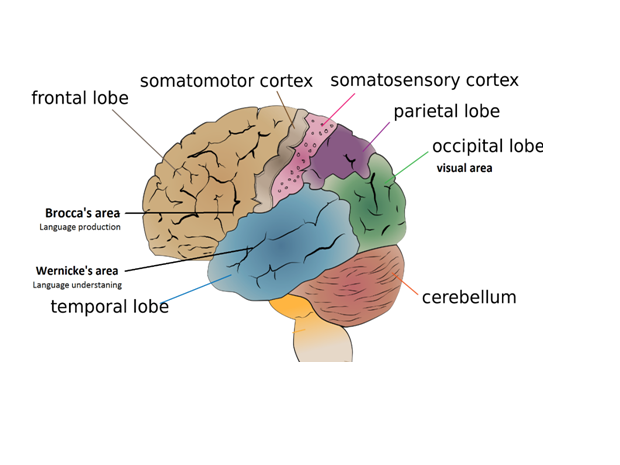Localisation of Function: How the Brain's Specialised Areas Shape Our Abilities
The human brain is a fascinating organ, responsible for controlling our thoughts, movements, and perceptions. Within this intricate system, the concept of localisation of function asserts that specific brain areas are dedicated to particular functions like language, memory, and hearing.
Although early theories like phrenology were discredited, advancements in research and technology have shed light on the functional organisation of the brain.
In this section, we'll explore the different brain regions responsible for visual and auditory processing, motor control, somatosensory perception, and language processing.

Visual and Auditory Centres
Let's start with our sense of sight. The primary visual centre is located in the visual cortex within the occipital lobe. However, visual processing begins in the retina, located at the back of our eyes. The retina captures light and sends nerve impulses to the brain via the optic nerve. These impulses are then relayed to the visual cortex through the thalamus, a crucial relay station. The visual cortex is divided into different areas, each processing specific visual information such as colour, shape, or movement.
Moving on to our sense of hearing
The auditory centre resides in the temporal lobes on both sides of the brain. The auditory cortex, within this region, plays a vital role in processing sound. The journey of sound begins in the cochlea of the inner ear, where sound waves are converted into nerve impulses. These impulses travel through the auditory nerve to the brainstem, where basic decoding occurs. Next, the thalamus acts as a relay station and performs additional processing. Finally, the auditory cortex recognises the sound, leading to an appropriate response.
Motor and Somatosensory Areas
Now let's delve into the areas responsible for motor control and somatosensory perception. The motor cortex, located in the frontal lobe, generates voluntary movements. Each hemisphere of the brain has a motor cortex, with one side controlling the muscles on the opposite side of the body. Different parts of the motor cortex control specific body parts in a logical arrangement. For instance, the region responsible for foot movement is located next to the area controlling leg movement.
On the other hand, the somatosensory cortex, situated in the parietal lobe, detects sensory events from various body regions. This region processes sensory information related to touch, such as pressure, pain, and temperature. Using information from the skin, the somatosensory cortex localises these sensations to specific body regions. Similar to the motor cortex, both hemispheres of the brain have a somatosensory cortex, with each receiving sensory input from the opposite side of the body.
Language Centres
Language is an incredible human capability, and it involves specialised brain regions. Broca's area, named after Paul Broca, a French neurosurgeon, is critical for speech production. Broca identified this area while treating a patient named Tan, who could understand language but struggled to speak or write. Broca studied similar patients and found that damage to the left frontal hemisphere led to language deficits. This area is believed to play a crucial role in speech production.
Another language-related area is Wernicke's area, discovered by Carl Wernicke, a German neurologist. Wernicke's area, located in the left temporal lobe, is involved in language comprehension. Patients with damage to this area can speak fluently but struggle to understand language. Wernicke proposed that language involves separate motor and sensory regions located in different cortical regions. The connection between Broca's and Wernicke's areas, known as the arcuate fasciculus, plays a vital role in language processing.
Evaluation/Discussion
While the concept of localisation of function has gained support, there are challenges and alternative viewpoints.
The equipotentiality theory
Suggests that higher mental functions are not strictly localised and intact brain areas can compensate for specific cognitive functions. Additionally, research indicates that communication between brain regions is crucial for cognitive processes. Complex behaviours like language, reading, and movement involve a series of interactions between different brain structures, and damage to these connections can lead to impairments similar to localiSed brain damage.
Supporting evidence for language centres
Comes from studies on aphasia, language-related impairments. Damage to Broca's area often results in expressive aphasia, where individuals have difficulty producing language. In contrast, damage to Wernicke's area leads to receptive aphasia, impairing language comprehension. These findings demonstrate the distinct functions of these brain regions in language processing.
Individual differences in brain activation and anatomical variations further emphasiSe the complexity of language processing. Studies have shown variability in brain activation patterns across individuals during language-related tasks.
Moreover, gender differences in the size of language-associated brain areas, such as Broca's and Wernicke's areas, may contribute to variations in language abilities.
Language production is not solely confined to Broca's area.
Research using advanced imaging techniques has revealed that other brain regions may contribute to speech abilities. This highlights the intricate networks involved in language and cognition, extending beyond isolated brain regions.
Conclusion
Understanding the localisation of function in the brain provides insights into how our brain is structured and how different regions contribute to specific functions.
The visual and auditory centres process visual and auditory information, while the motor and somatosensory areas control voluntary movements and sensory perceptions. Broca's area and Wernicke's area play key roles in language production and comprehension, respectively. While challenges and alternative theories exist, studying brain regions and their interactions enhances our comprehension of complex cognitive processes.
Now that you've learned about localisation of function, put your knowledge to the test! Take our quiz below to further deepen your understanding and discover how the brain's specialised areas shape our abilities.




